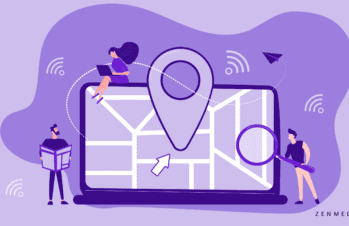The Ultimate Guide to Social Media Platforms for B2B Influencer Marketing
With the rise of social media, influencer marketing has become a powerful tool for businesses to reach their target audience and drive real business results. But with so many platforms to choose from, it can be difficult to know where to focus your efforts.
In this article, we’ll explore the main influencer platforms, their key demographics, what content performs well on each platform, and how to find the right influencer for your campaign. But first, let’s explore the basics of influencer marketing and why companies—especially B2Bs—need to hop on this marketing trend.
What is Influencer Marketing?
Influencer marketing is partnering with influencers (people with a large and/or engaged following on social media) to promote your products or services. Think of it as having a squad of mini-celebrities who are passionate about your brand and can help you reach a wider audience. It’s like having your own personal word-of-mouth marketing team, but with a social media twist. And let’s be real, who doesn’t love a good recommendation from someone they trust?
For B2B companies, influencer marketing is a game-changer. It allows you to reach your target audience in a more authentic and relatable way, and it can help you establish yourself as a thought leader in your industry.
What’s the value of influencer marketing for B2Bs?
B2B marketers should consider partnering with influencers who have a strong presence in their industry and are well-respected by their peers. These influencers should have an engaged social media following and be well-versed in the products or services the B2B company offers. They can be industry experts, thought leaders, or even customers who have successfully used the company’s products or services.
These influencers can be found on various platforms like Instagram, TikTok, LinkedIn, X (formerly Twitter), Facebook, YouTube, and more. It is important for B2B marketers to research and carefully select influencers who align with their brand’s values and message to ensure a successful partnership.
What’s the deal with micro-influencers?
Micro-influencers are individuals with a smaller but highly engaged following on social media. They often have a very specific niche audience and are usually experts in a specific industry or topic. In B2B marketing, micro-influencers can be valuable assets because they can help you reach your highly specific and targeted audience.
One of the main benefits of working with micro-influencers is that they tend to have a higher engagement rate with their followers than macro-influencers, who have more followers but see less meaningful engagement. Micro-influencers’ followers tend to hold the influencer’s opinions and recommendations in high regard and are often more likely to actually take action based on their suggestions. This is especially important for B2B marketers because the B2B buyer’s journey is usually more complicated and involves more decision-makers than the buyer’s journey for B2C products.
Micro-influencers also tend to be more cost-effective than macro-influencers. Due to their smaller following, micro-influencers typically charge less for sponsored posts or partnerships. This can be especially beneficial for B2B companies with smaller marketing budgets.
Another benefit of working with micro-influencers is that they often have a more authentic and personal relationship with their followers. This can result in more genuine and credible endorsements of a B2B company’s products or services. Micro-influencers can be a valuable asset for B2B marketers looking to expand their social media presence and reach a specific, engaged, and targeted audience in a cost-effective and authentic way.
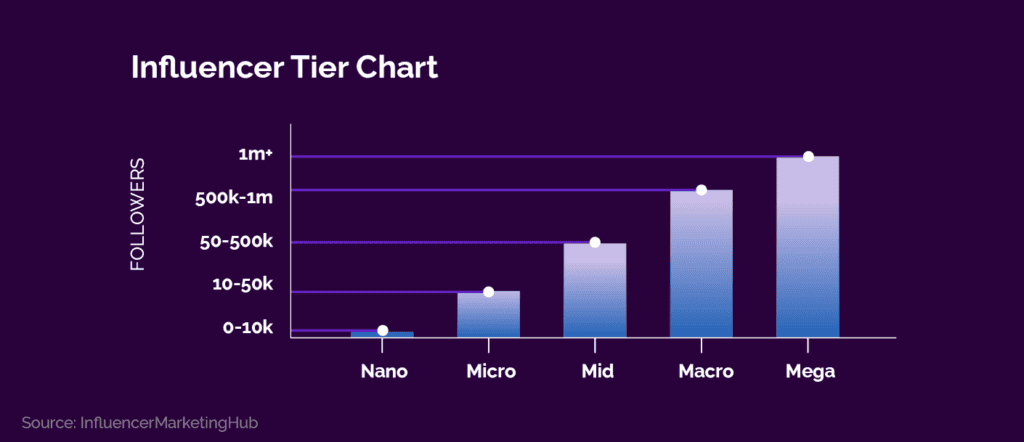
How much does influencer marketing cost?
We’ve detailed each platform’s average cost per post in the sections below. The rates we outline are based on the influencer tier chart above and information from three sources: Influencer Marketing Hub, a marketing resource for agencies; Shopify, an all-in-one commercial platform for businesses; and inBeat, a platform dedicated to helping influencers. These two resources enable us to provide solid estimates for influencer rates, but it’s important to remember that, like social media, these rates are subject to change.
Rates may also vary based on location, social channel, engagement levels, conversion rates, types of content created, campaign duration, influencer reach, niche or industry, and more. Generally, influencers with a larger following and higher engagement rates will command a higher fee than those with a smaller audience.
If you want this element of your social media strategy to go deeper than simply cost per post, another way to measure influencer pricing is through a cost per engagement (CPE) analysis. CPE can be calculated by dividing the total spend by the number of engagements.
It’s also important to note that the cost of influencer marketing goes beyond the cost of a sponsored post. Additional costs, such as the cost of creating the content, the cost of managing the campaign, and the cost of measuring and analyzing the results, should also be taken into account. Additionally, B2B influencer marketing can be done through different types of collaborations, such as brand ambassadorship, affiliate marketing, product reviews, event collaborations, and more, all of which may have different pricing structures and require different types of agreements.
Brands need to clearly understand their budget and goals before creating a contract and vetting potential influencers. When in doubt, brands should either reach out to influencers directly or search their websites for rate sheets. Alternatively, brands can choose to leverage a b2b influencer marketing agency. Marketing agencies speed up the process by offering expertise, connections, and outreach that can significantly enhance campaign effectiveness.
Which Social Media Platform is Best for B2B Influencer Marketing?
The platform you select for your influencer campaign should be determined by where your B2B audience is what is most likely to influence them. LinkedIn is the classic B2B platform since it caters to businesses and the more professional sphere.
We believe that all B2B companies need a strong LinkedIn presence, and influencer marketing on LinkedIn can reap great results. That said, since video is the king of the content game right now, B2Bs need to think outside the box when determining which platform—or platforms—to target for their B2B influencer marketing campaigns.
Let’s look at the main platforms being used in B2B influencer marketing and the audiences they speak to.
TikTok: The New Kid on the Block
TikTok may seem like just a platform for lip-syncing and viral dance challenges, but it’s quickly becoming a powerful tool for B2B brands to connect with their target audience and drive real business results. Available in over 160 countries, TikTok has more than 1.1 billion users and has been downloaded over 220 million times in the U.S. alone, offering a diverse user base that includes professionals across all industries and age groups.
TikTok is particularly popular among younger generations, with the majority of users being under 30. This makes it a great platform for businesses that target a younger demographic (not to mention millennials and Gen Z make up 62% of B2B buyers). Although everyone may have first heard of the app from their younger cousins, nieces, nephews, or even their own children, the platform experienced a significant increase in usage among working adults during the pandemic. At that time, many turned to the app for entertainment and inspiration while working from home. Today, TikTok is a ubiquitous social media platform.
With such a huge audience, TikTok offers a unique opportunity for B2B brands to reach a large and diverse audience in a creative and engaging way. By partnering with the right influencers, B2B brands can increase brand awareness and generate leads.
TikTok User Demographics
TikTok has a diverse user base that includes people of all ages and industries. However, the majority of TikTok users are younger generations, such as Gen Z and millennials.
- The majority (80%) of TikTok users are between the ages of 16 and 34.
- Almost all of TikTok’s users, save 7%, are under 50 years of age.
- The platform leans female, with 60% of users identifying as female and 40% identifying as male.
- TikTok is particularly popular among urban and suburban users, with about 44% of users living in urban or suburban areas and only 18% in rural areas.
- The app is split fairly equally amongst users of different ethnicities. According to Pew Research Center, the American user breakdown included 31% Hispanic American users, 30% African American users, and 31% Caucasian American users.
- According to GlobalWebIndex, the most prominent vibe given off by TikTok content is funny (75%), followed by creative (61%), trending (45%), informative (32%), and motivational (32%).
It’s important to note that TikTok’s algorithm and user behavior can change over time, so staying updated and adapting your TikTok B2B strategy accordingly is essential.
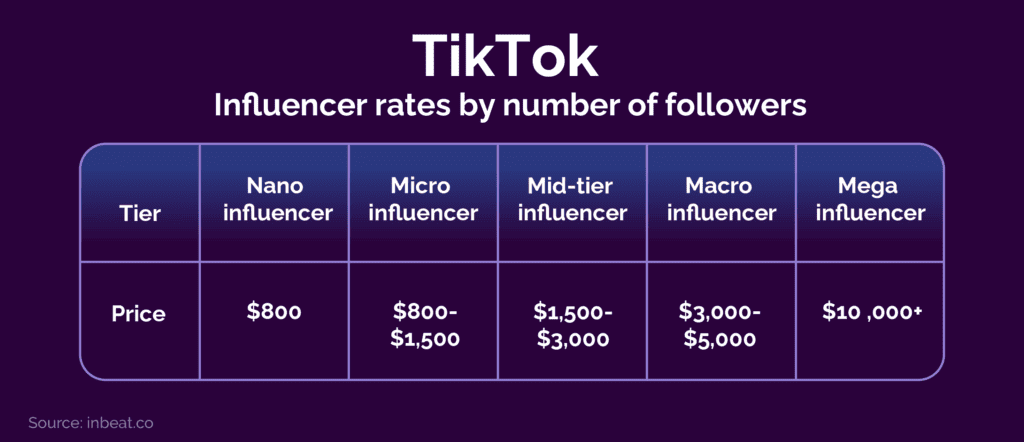
Cost of Influencer Marketing on TikTok
Not only is TikTok climbing in popularity, its algorithm and reach is disrupting traditional pricing models and influencer rates. Some nano influencers may reach millions of views each month, while some macro influencers may have larger follower counts with less engagement. Shopify notes macro and mega influencers may even earn more than $10,000 per post.
If you’re not sure how to budget for TikTok, try this formula from InBeat or plug information into an earnings calculator:
CPM (cost per thousand) = (Average number of views, likes, and comments based on the last five TikTok pieces) / cost of content
YouTube: The OG of Video Content
YouTube may have started as a platform for cat videos and makeup tutorials, but it’s now the largest video-sharing platform in the world. The platform boasts over 2.7 billion active monthly users. The platform is particularly popular among older generations, with the majority of users being over the age of 30.
YouTube favors long-form, educational content that is informative and relevant to the user. The platform’s algorithm favors well-produced, well-researched content that provides value to viewers. So, YouTube is a great platform for businesses that want to create in-depth, educational content that will establish them as thought leaders in their industry.
YouTube User Demographics
YouTube has a diverse user base that includes people of all ages, genders, and locations.
- 56% of Gen Z, 54% of millennials, 48% of Gen X, and 26% of boomers say they most often discover new products on YouTube.
- The vast majority of adults under the age of 65 say they use YouTube. Males aged 25 to 34 make up the site’s largest audience, drawing in 12.2% of users under age 65.
- YouTube has a diverse user base in terms of gender, with a slight majority of users being female (51%).
Cost of Influencer Marketing on YouTube
YouTube influencer marketing is arguably one of the most expensive types of influencer marketing. Still, in general marketing terms, it’s a cost-effective way to reach a target audience, especially for B2Bs working with smaller influencers that have niche audiences. Content creators on YouTube can receive income through multiple channels, including monetizing their videos, Google Adsense, and paid opportunities. Calculators can help determine the amount an influencer might earn on YouTube.
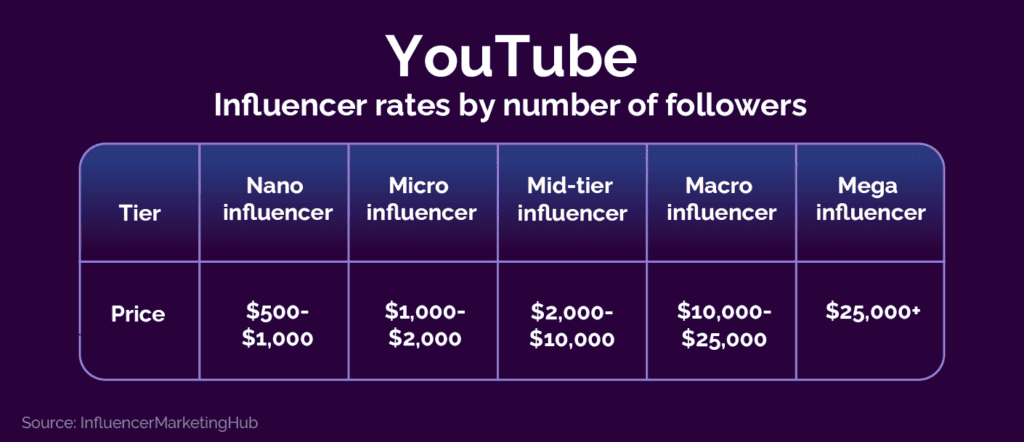
Instagram: The Picture-Perfect Platform
Puppy pics and latte art abound, Instagram is a visual-based platform that focuses on high-quality, aesthetically pleasing content. The platform has over 2 billion monthly active users, with a diverse user base that includes people of all ages and industries.
Instagram favors visually stunning, high-quality photos and videos that are creative and unique. Its algorithm favors content that is relevant to the user. With Instagram’s emphasis on aesthetics, it’s a great platform for businesses that want to visually showcase their products or services. The platform also offers a variety of selling tools that allow marketers to include shopping links directly in posts.
Interestingly enough, the “picture-perfect” platform favors video content, with video posts receiving twice as much engagement as photo posts. Additionally, Instagram’s feature of IGTV (Instagram TV) is also prioritized in the algorithm, and it allows for longer-form video content.
Instagram also amplifies any content that receives engagement quickly after being posted. A study by BuzzSumo found that posts that receive engagement within the first hour of being posted are more likely to be shown in users’ feeds than posts that receive engagement later.
Instagram User Demographics
Instagram is one of the most popular social media platforms, with over two billion monthly active users worldwide. The platform is particularly popular among younger demographics, with a significant portion of its user base falling within the age range of 25 to 34.
- 90% of users follow at least one business account on Instagram.
- The platform is split fairly evenly when it comes to gender.
- India, the U.S., and Brazil lead the world in countries with the most Instagram users.
- Research shows that Instagram has influenced buyers’ purchasing decisions, with many users saying they’ve made a purchase after seeing something in the app.
- Users love to engage with Instagram carousels and video, so B2Bs should prioritize that kind of content when working with influencers on the platform.
Cost of Influencer Marketing on Instagram
On Instagram, influencer marketing pricing models tend to stick to the basic formula of more followers = higher cost. However, Instagram influencers have also been known to break down costs based on the kind of content. In doing this, influencers can charge a premium for content that performs well and is more complex to make—like video, for example—and short-lived posts, like Instagram Stories, may cost less.
You may also need to account for travel, wardrobe, or other expenses and resources used to create content. To see what an influencer might charge on Instagram, reference earnings calculators like this one from Influencer Marketing Hub.

LinkedIn: The B2B Stronghold
As the original social media home for B2Bs, it would be remiss not to include LinkedIn in this list. In reality, every B2B should have a presence on LinkedIn—no matter what—and pieces of content posted on other platforms should likely be repurposed for your LinkedIn audience. LinkedIn influencer marketing allows brands to reach decision-makers and influencers in specific industries and roles. Plus, LinkedIn’s algorithm is tailored to deliver content to users based on their professional interests, making it more likely that your content will be seen by the right people.
Influencer marketing on LinkedIn can also help to build trust and credibility, as influencers on the platform are typically thought leaders and experts in their respective fields.
LinkedIn User Demographics
LinkedIn has a diverse user base that includes professionals from various industries, job titles, and locations. Users on LinkedIn are looking to network, develop their careers, and connect with like-minded professionals. LinkedIn is a great platform for B2B businesses to connect with customers and partners, find new business opportunities, and build brand awareness.
- LinkedIn has over 1 billion members across 200 counties, with a majority of users being professionals in various industries.
- According to Statista, LinkedIn has the highest penetration among the 25 to 34 age group by far, with nearly 60% of the user base worldwide falling into the category.
- LinkedIn’s audience has two times the buying power of the average audience—and four out of five members are drivers of business decisions.
Cost of Influencer Marketing on LinkedIn
The average cost of influencer marketing on LinkedIn can vary widely, just like the other social platforms. For example, LinkedIn Lives can start at $1,000, but it depends on the industry, influencer reach, engagement rate, and the topic. While there isn’t a consensus on influencer rates per post and tier, we’ve found LinkedIn influencers generally receive between $X-X. Additionally, many LinkedIn influencers may be open to cross-brand promotions, discount codes, speaking opportunities, or access to products and services.
LinkedIn influencers are unique in that they are typically thought leaders and industry experts. Unlike other influencers on platforms like Instagram or TikTok, they are not primarily focused on monetizing their posts. Many of them are founders and executives at leading companies, and they use their platform to share valuable insights, best practices, and thought leadership articles on topics related to their industry. They don’t seek to earn a quick buck by promoting products or services. Instead, they are more focused on building and maintaining their credibility and influence among their peers and followers.
When working with LinkedIn influencers, it’s important for B2Bs to understand that these individuals have built a strong online presence by being credible and knowledgeable sources in their field. They seek partnerships that align with their own values and interests and can provide value to their network. They often represent companies they have founded or are leaders in the companies they work for. For them, it’s important to maintain that credibility and to be able to influence the opinions of other decision-makers in their industry.
Facebook: The Original “Social Network”
Almost 3 billion monthly active users utilize Facebook, making it one of the most widely used social media platforms in the world. According to a survey by Pew Research Center, 68% of American adults use Facebook, making it a valuable platform for B2Bs to reach a large and diverse audience. Additionally, Facebook offers a variety of targeting options, allowing B2Bs to reach specific demographics, interests, behaviors, and locations.
It’s also important to note that Facebook’s algorithm has changed frequently in the past few years. Recently, it has been prioritizing content from friends and family, which makes it a bit harder for brands to reach their target audience organically. This can make influencer marketing on Facebook more effective for B2Bs than traditional organic social media marketing, as influencers have built a large and engaged following on the platform, and can increase the reach and visibility of the brand’s content.
Facebook User Demographics
It may have begun as a platform for college students, but Facebook wins with the older crowd these days. It’s no secret that you’re more likely to see someone’s grandma actively scrolling on Facebook in the waiting room of their doctor’s office than you are to see someone’s teenage son scrolling the platform on his bus ride home.
- As of December 2022, users aged 25 to 34 years comprise Facebook’s largest audience in the U.S., accounting for 24.4% of the social network’s user base.
- We didn’t lie! The platform is also really popular with older adults, with 58% of people aged 65 or older having used the platform. Compare that to their usage rates of Instagram and LinkedIn—15% and 12%, respectively.
- Education and income also play a role in Facebook’s user demographics. The platform is most popular among those with higher levels of education and income, with 73% of college graduates and 70% of those earning $75,000 or more per year.
Cost of Influencer Marketing on Facebook
Right up there with YouTube, Facebook can be costly for influencer marketing campaigns when talking about large influencers with huge followings. But in the nano- to mid-tier levels of influencers, marketers can expect a reasonable price tag.
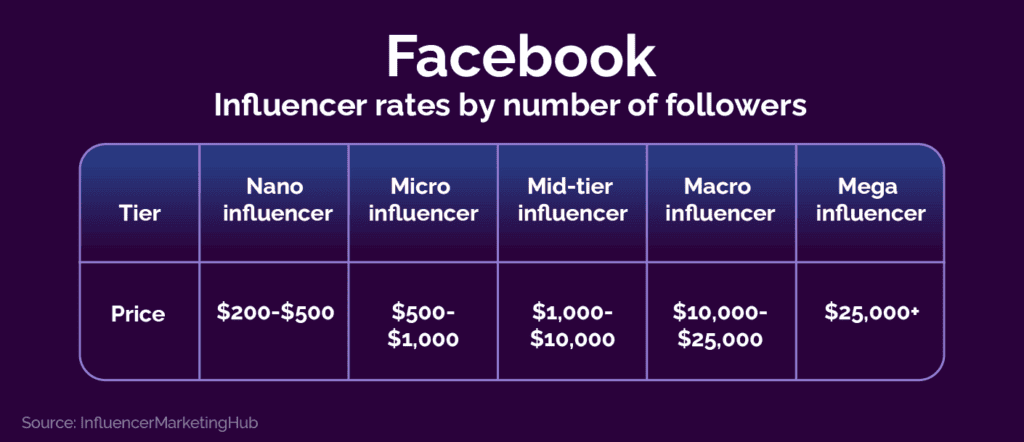
X: For the Influencer of Few Words
Sure, X (formerly Twitter) may not be the belle of the influencer ball, but don’t let that fool you—this platform still packs a punch with over 330 million monthly active users. And where there’s a crowd, there’s bound to be influencers.
X User Demographics
X is most popular among adults aged 25 to 34 (29.6%), followed by 18 to 24-year-olds (28.4%). People over 35 account for 42% of the platform’s total users. X may not have the same number of users as other social media giants, but with 23% of American adults using the platform, it can still have an impact, especially when working with niche influencers.
- 61% of X users say they use the platform for news and current events.
- In the United States, 53% of Americans reported they regularly get news from X.
- Male audiences account for 36% of global X users.
Cost of Influencer Marketing on X

Soon after Twitter rebranded to X, the platform introduced options that enabled certain users to monetize. As a result, influencers may still be figuring out their rates, so reaching out to them for information is the best approach here. In general, WebFX reports that X offers the lowest-cost influencer marketing options, ranging from $2 a post for an influencer with 1,000 followers to $2,000 for an influencer with 1 million. However, keep in mind that these numbers may be much higher depending on the creator, the content, and the campaign.
Creating a Winning B2B Influencer Marketing Strategy
To create a successful B2B influencer marketing strategy, it’s important to research and carefully select influencers who align with your brand’s values and message. Look for influencers who are experts in your industry and have a strong following on your target platform (or platforms).
Be creative and think outside the box. These platforms offer a wide range of creative tools that can be used, so be sure to take advantage of trending filters, templates, sounds, and editing techniques to increase your rank and engagement. The influencer you choose to work with should be well versed in the trends on their platform, but your marketing team should feel empowered to ask them to follow a trend or create content around a specific concept. But there are a lot of steps before you get to that point, so here’s a step-by-step breakdown of how to develop your own B2B influencer marketing strategy:
- Define the target audience: Before working with any influencer, it’s important to clearly define the target audience for the B2B brand. This will help to identify influencers whose audience aligns with the target market.
- Research influencers: Research potential influencers on YouTube by looking at their audience demographics, reach, engagement, and the types of content they produce. Look for influencers who are active in your industry, have a high engagement rate, and have an audience that intersects with yours.
- Set clear objectives: Set clear and measurable objectives for the influencer campaign, such as increasing brand awareness, driving website traffic, or boosting conversions.
- Develop a content plan: Work with the influencer to develop a B2B content marketing plan that aligns with the brand’s objectives. This could include creating product demos, tutorials, or interviews with industry experts.
- Leverage the influencer’s audience: Leverage the influencer’s audience by encouraging them to engage with the brand’s content, buy your products, or visit your website. Use your CTA to send them there!
- Measure and analyze the results: Measure and analyze the results of the campaign to track its effectiveness. Use metrics such as views, likes, comments, and website traffic to evaluate the success of the campaign and make any necessary adjustments.
- Continual optimization: Continuously optimize the strategy by experimenting with different formats, types of content, and influencers to find what works best for the brand and its target audience.
- Maintain a lasting relationship: Maintain a lasting relationship with the influencer, as they can be valuable brand ambassadors in the long run—even after the end of the campaign.
Leveraging Influencer Content Across Platforms
While you may strike up a partnership on a single platform, we recommend reserving the right to share any content created during an influencer partnership across any and all of your platforms. From a content creation standpoint, this can help you save time and money. It also enables you to stay in front of your audience’s eyes with a credible third-party’s perspective.
Brands can leverage influencer content across platforms in several ways:
- Repurpose content: Brands can repurpose influencer-generated content across different platforms to get a bigger bang for their buck and reach a wider audience. For example, a brand could repurpose a TikTok influencer’s video content and turn it into an Instagram reel, or they could take a short video clip from an influencer’s Instagram story and turn it into a YouTube short.
- Cross-promote content: Brands can cross-promote influencer-generated content across their own social media platforms. For example, a brand can share an influencer’s Instagram post on their own Instagram story and ask their followers to check out the influencer’s page.
- Repost influencer content across a brand’s social media channels: By sharing an influencer’s content on a B2B brand’s own social media channels, B2Bs can extend the reach of the influencer’s message and increase brand awareness.
- Multi-platform campaigns: Brands can work with influencers to create digital campaigns that span multiple platforms. For example, an influencer could create a video for a brand’s YouTube channel and then repurpose that video into shorter clips for Instagram and TikTok.
- Influencer takeover: Brands can leverage an influencer’s following by allowing them to take over their social media accounts for a day and post content on their behalf. This will give the brand access to the influencer’s followers and increase their reach.
- Incorporating influencer content into your website: B2Bs can incorporate influencer content into their website by embedding videos, adding photos to product pages, or featuring quotes from the influencer in blog posts. This can help to increase credibility and trust among potential customers.
Beyond creating cross-platform momentum, brands should also consider how they can deepen their relationship with the influencers they work with, and begin to leverage their networks as well. This can mean using the influencer’s audience for lead generation, market research, product testing, and more. By leveraging the influencer’s network, B2B brands can increase their reach and engagement with potential customers and gather valuable insights they can leverage to improve their products and services.
For example, a brand could conduct market research using an influencer’s network to gather feedback and insights from potential customers. This can be done through surveys, polls, or Q&A sessions that the influencer conducts on behalf of the brand. To leverage the influencer’s network for lead generation, B2B brands can direct the influencer’s followers to the brand’s website or landing page. The influencer can achieve this by including a call to action in their post or using a unique tracking link.
What Kind of Influencer Is Right for Your B2B?
The kind of influencer B2Bs partner with will always depend on the specifics of the company, industry, and marketing campaign’s goals. Matching the influencer with the audience is important for B2Bs because it helps ensure that the influencer’s message reaches the right people. The brand’s confidence in reaching potential customers who are most likely to be interested in its products or services is boosted by selecting an influencer whose audience aligns with the target market for the B2B brand. This alignment ensures that the brand’s message resonates effectively with its intended audience.
To match the influencer with the audience, B2B brands can do the following:
- Review your buyer personas and make sure they are accurate. Your influencer should be someone who speaks to your buyer persona demographics—sometimes that means they will fall within the same demographics or have similar traits.
- Research the audience demographics of the influencer, such as age, gender, location, interests, and profession.
- Assess the influencer’s reach and engagement with their audience.
- Analyze their content and previous collaborations to ensure they align with the brand’s values and message.
- Reach out to the influencer and discuss their audience and how they align with the brand’s target market.
- Look at the influencer’s engagement and audience demographics in their social media analytics.
- Discuss your goals and how they coincide with the influencer, and with their audience.
By taking these steps, B2B brands can identify influencers whose audience aligns with the target market and increase the chances of the message resonating with the right people. Some types of influencer partnerships that may benefit B2B brands include:
- Industry thought leaders and subject-matter experts who can speak to the specific needs and pain points of the target audience
- Influencers with a large following in a particular industry or niche, as they can help to increase brand visibility and credibility within that market
- Micro-influencers who have a smaller, but highly engaged audience in the B2B industry. They can be a cost-effective way to reach a targeted audience.
- User-generated content campaigns where customers and employees act as influencers to promote the brand.
- Influencer-led webinars, events, or roundtable discussions where the influencer can showcase the brand’s expertise and thought leadership in the industry.
Another factor to consider when deciding what kind of influencer is right for your B2B is knowing who your audience is. With access to so many thought leaders and opportunities to network, it’s no wonder LinkedIn retains its status as the preferred social channel for B2B marketers.
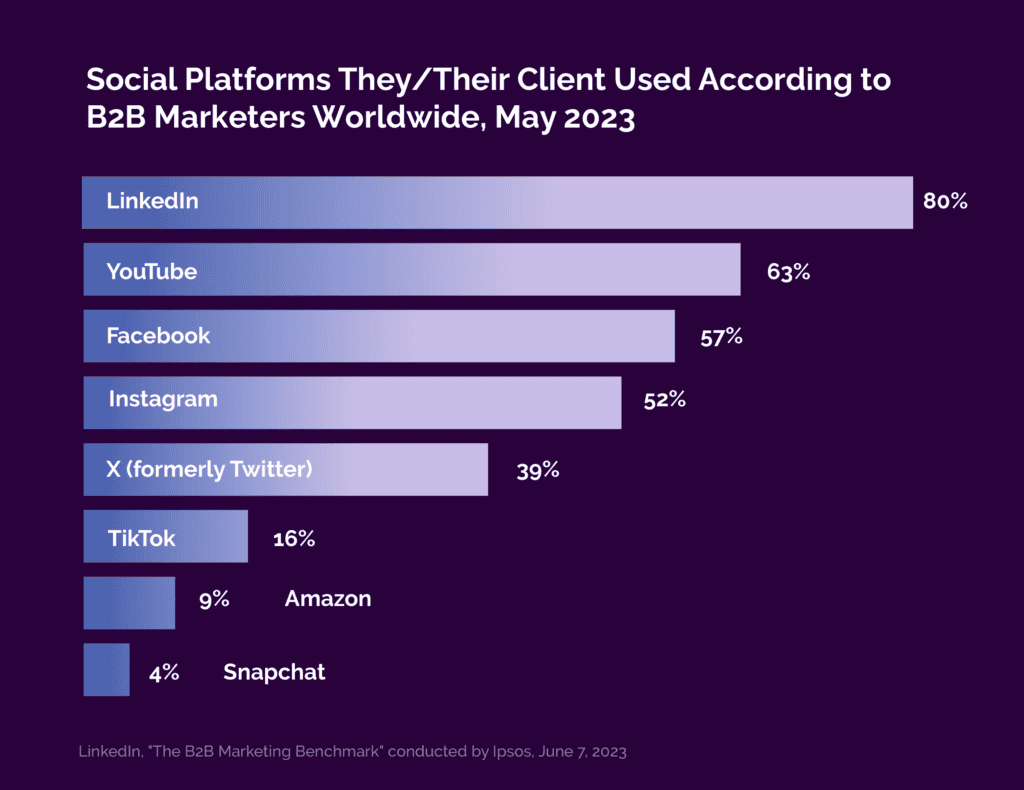
Final Thoughts
Influencer marketing is a powerful tool businesses can leverage to reach their target audience and drive real business results. TikTok, YouTube, Facebook, Instagram, LinkedIn, and X are all great platforms for influencer marketing, but each platform has unique strengths and target demographics. By understanding these differences, you can choose the right platform for your campaign and reach your target audience more effectively.
Video content is a key factor in influencer marketing success. Finding influencers willing to create video content can significantly enhance your strategy, as video content tends to be more engaging and shareable than non-video content. To make the most of your partnership, make sure you discuss the prospect of sharing influencer-created content across multiple platforms, even including it on your company website.
The key to success in influencer marketing is understanding your target audience and creating engaging, appealing, and informative content. By working with influencers who have a strong presence on the platforms that align with your target audience and repurposing content across multiple platforms, you can increase your reach and achieve positive results for your business.




